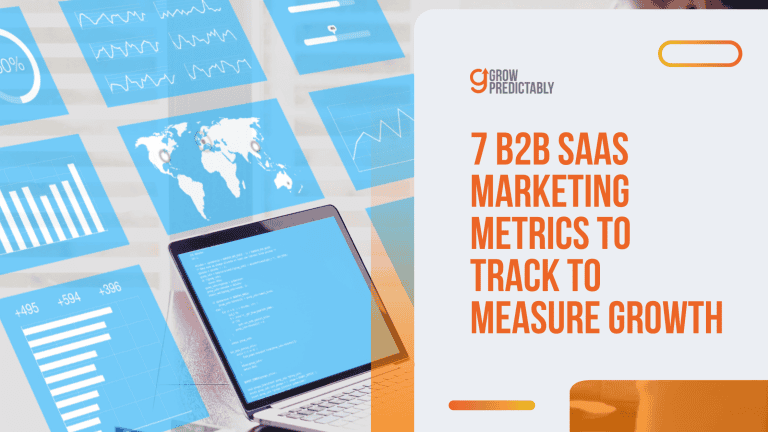Effective B2B SaaS Keyword Research Strategies: A Complete Guide for 2025
What if your current keyword strategy is sabotaging your SaaS growth?
You’re not alone—81% of B2B marketers overlook intent when selecting keywords.
But solving that problem can drive qualified traffic that’s ready to convert.
This guide breaks down the exact B2B SaaS keyword research strategies working in 2025, focusing on a structured keyword research process.
Ready to move past guesswork?
Let’s start.
Understanding User Intent
Search behavior reveals the raw psychology of how people hunt for solutions online.
When someone types into that search bar, they’re leaving digital breadcrumbs that expose exactly where they are in their buying journey.
What makes this fascinating is how the same person searching for the same end goal will radically shift their search patterns as they move from awareness to consideration to decision.
Each variation in search behavior unlocks a different segment of your market – and knowing how to tap into each one is what separates 6-figure businesses from 7-figure empires.
Keywords and Their Categories
The traditional view of keywords as just search terms is dead wrong.
Keywords are behavior signals – they tell you exactly what stage of awareness your market is in and how close they are to pulling out their credit card.
According to Conductor’s research, 80% of B2B buyers start their journey with a generic search.
Understanding these patterns isn’t just marketing – it’s money in the bank.
Take a software company selling project management tools: their potential customers might start with “how to manage remote teams” before progressing to “best project management software for remote teams” and finally “Asana vs Monday pricing.”
Informational Keywords

When someone hits Google with a “how to” or “what is” search, they’re telling you they’re stuck with a problem but haven’t found their solution yet.
This is where you plant your flag as the authority.
The key is recognizing that these searches are your chance to build trust before asking for the sale.
According to Backlinko’s analysis, informational content drives 77% of all search traffic.
Master this category, and you’ve got a direct line to your market’s pain points.
Using keyword tools to identify these informational keywords can help validate opportunities, gather data on search volume, and analyze keyword difficulty, informing your SEO strategy.
- Create detailed technical documentation (e.g., “Complete Guide to Implementing SSO Across Enterprise Applications” or “Multi-Cloud Migration Strategy Playbook”)
- Focus on actionable insights that deliver immediate business value (like “5 Steps to Reduce Cloud Computing Costs by 30%”)
- Build trust by sharing enterprise case studies (such as “How Fortune 500 Companies Handle API Security”)
Navigational Keywords
Navigational searches reveal brand awareness and market positioning.
These people already know where they want to go – they just need directions.
This is pure market intelligence telling you exactly which brands own mindshare in your space.
Google’s own data shows that 39% of search queries have navigational intent.
- Monitor enterprise branded search volume (like “Snowflake data warehouse reviews” or “ServiceNow ITSM pricing”)
- Optimize for variations of your brand name (such as “MS Teams” vs “Microsoft Teams enterprise”)
- Capture competitor navigational traffic with strategic comparison content (“Workday alternatives for enterprise HR”)
Transactional Keywords
This is where intent transforms into income.
These searches come from people who have their wallets out and are ready to buy – they just need to know who to trust with their money.
These keywords typically have the highest conversion rates but also the fiercest competition.
WordStream reports that transactional keywords can convert at 10x the rate of informational terms.
- Target specific enterprise features (“HIPAA compliant cloud storage solution”)
- Focus on terms that indicate buying readiness (“enterprise SSO implementation partner”)
- Use pricing and compliance modifiers (“SOC 2 compliant CRM enterprise pricing” or “GDPR ready data warehouse solutions”)
Every search query is a signal.
The businesses that win are the ones that understand these signals and position themselves exactly where their market is already looking.
This isn’t about gaming the system – it’s about being there with the right message when your market needs you most.
Importance of Matching Content with User Intent
Let’s say you sell software that helps companies manage their HR documents.
Your potential customer (let’s call her Sarah, an HR Director) starts searching online because her team is drowning in paperwork.
At first, she searches “how to organize employee documents digitally” – she’s exploring the problem.
A few days later, she searched “best HR document management software” – she’s now looking for solutions.
Finally, she types “DocuHR enterprise pricing” – she’s ready to buy.
If all your content only shows pricing plans and feature comparisons, you’ve lost Sarah during her early research phase.
On the flip hand, if someone’s ready to buy and you show them “What is document management?” – they’ll bounce faster than a rubber ball.
According to Gartner, B2B buyers spend 17% of their time meeting with potential suppliers.
Your content needs to do the heavy lifting when you’re not in the room.
Think about these real-world scenarios:
- A startup HR manager searching “employee file storage compliance” needs different content than one searching “HR software demo request”
- Someone typing “DocuHR vs PaperlessHR features” isn’t looking for basic definitions – they need clear comparison charts
- A search for “HR document software implementation timeline” needs a roadmap, not a sales pitch
Strategy for Content Creation
Imagine you’re running a restaurant.
You wouldn’t serve dessert menus to people who haven’t even decided if they want to eat at your place.
The same goes for B2B software.
Demand Gen Report shows that 62% of B2B buyers rely heavily on content to make purchase decisions.
You need content that serves every type of “customer appetite.”
Here’s how to build your content menu:
- For the researchers: Create how-to guides like “5 Ways to Speed Up Employee Document Processing” or “Guide to HR Document Compliance”
- For the comparison shoppers: Build comparison tools like “HR Software Features Checklist” or “Pricing Calculator”
- For the ready-to-buy crowd: Provide implementation guides, case studies, and clear pricing information
Let’s take a real example.
A company selling email marketing software should have:
- Educational content: “How to Build Your First Email List” or “Understanding Email Deliverability”
- Comparison content: Clear feature comparisons with major competitors, pricing breakdowns
- Purchase content: Implementation guides, API documentation, customer support details
This isn’t about throwing spaghetti at the wall.
It’s about having the right answer ready when someone asks the question.
When an IT manager searches “email marketing software security features” at 2 AM, your content should be there, answering exactly what they need to know.
That’s how you turn random searches into paying customers.
Every piece of content should answer a specific question or solve a specific problem.
No fluff, no confusion – just clear answers for real problems.
That’s what builds trust and closes deals in the B2B world.
The SaaS Keyword Research Process Blueprint

Here’s the reality of the SaaS keyword research process: Traffic means nothing without conversion intent or understanding search intent.
According to Semrush’s 2023 Market Analysis, businesses that dominate targeted keyword clusters with a clear understanding of search intent see 3x higher conversion rates than those spreading themselves thin across broader terms.
1. Talk to Your Sales Team
Your sales team holds the key to understanding your market’s exact search language and uncovering keyword difficulty challenges.
According to Gong’s Sales Intelligence Report, customer conversations reveal 62% more purchase-intent keywords than traditional keyword research tools alone, emphasizing the importance of aligning keyword choices with search intent.
Here’s where to mine customer language:
- Sales call recordings (especially discovery calls)
- Support ticket language patterns
- Customer success onboarding sessions
- Product feedback emails
- Cancellation reasons
When Monday.com started targeting software development teams, they discovered developers weren’t searching for “project management software” – they were searching for “sprint planning tools” and “agile team collaboration platform.”
Your market is literally telling you how they search, and understanding their search intent is crucial to success.
To validate these insights, use a keyword research tool to refine and prioritize the relevant keywords identified, considering their keyword difficulty.
2. Develop Your Corner of the Market
Market ownership starts with understanding your unique position and the search intent of your audience.
According to SEMrush’s Market Position Study, businesses that focus on specific market segments achieve 40% higher organic conversion rates by aligning their strategy with user search intent.
Core elements include:
- Deep-dive analysis of your market’s unique language patterns and terminology
- Identification of high-value keyword clusters that drive purchasing decisions
- Strategic mapping of content topics to specific buyer pain points and search intent
- Development of authority content that owns your market segment
3. Identify Relevant Keywords
Here’s where most companies crash and burn – they chase high-volume keywords they can never rank for due to high keyword difficulty.
When Pipedrive was starting, they ignored “sales CRM” (difficulty 87) and instead dominated “sales email tracking” (difficulty 34), a keyword with lower difficulty but relevant to their search intent.
According to Ahrefs’ 2024 Keyword Research Study, long-tail keywords drive 80% of B2B software traffic, indicative of nuanced search intent.
Analyzing competitor keywords is crucial to identify gaps and opportunities, allowing businesses to target profitable keywords effectively by understanding their difficulty and aligning with search intent.
Focus on keywords that:
- Match your prospect’s exact pain point
- Have enough search volume to matter (200+ monthly for B2B SaaS)
- Are actually possible to rank for (difficulty under 40 for newer sites)
- Show clear buying intent (“platform,” “software,” “tool” vs “what is,” “definition”), demonstrating a clear search intent
4. Group Keywords by Search Intent
Every B2B search reveals exactly where someone is in their buying journey, making search intent crucial.
According to Forrester’s B2B Purchase Study, typical B2B purchase cycles involve up to 27 touchpoints before a decision.
Utilizing a keyword tool to analyze and group relevant keywords by search intent can significantly enhance this process, allowing you to address keyword difficulty while targeting appropriate intent.
Think about Slack’s early journey – they owned every stage:
- Awareness searches: “how to improve team communication,” “remote team collaboration best practices”
- Consideration searches: “best team messaging apps,” “Microsoft Teams alternatives”
- Decision searches: “Slack enterprise pricing,” “team chat software security features”
5. Map Keywords to Decision Makers
Different stakeholders search differently for the same solution, making it important to align keyword strategies with search intent and keyword difficulty.
When Asana targets engineering teams, the same product gets searched in completely different ways:
Engineering Manager:
- “Agile project tracking”
- “Sprint planning software”
- “Development team workflow”
Product Owner:
- “Product roadmap tool”
- “Feature prioritization software”
- “Product backlog management”
CTO:
- “Project management security compliance”
- “Enterprise workflow solution”
- “Development process scaling”
6. Find Hidden Keyword Opportunities
When Notion started challenging Confluence, they discovered massive opportunities in keywords their competitors ignored by understanding search intent linked with keyword difficulty.
According to Ahrefs’ Commercial Intent Study, these longer, more specific target keywords often convert at 2-5x the rate of shorter, generic terms:
- “Remote team wiki software”
- “Company knowledge base template”
- “Team documentation best practices”
Advanced SaaS Keyword Research Tactics
Master these advanced strategies to pull ahead of 90% of your competitors:
Seasonal Opportunities:
- Track enterprise software search spikes (usually Q4 and Q1)
- Monitor industry event-related search trends
- Watch for compliance deadline-driven searches
Geographic Variations:
- “SaaS” vs “Cloud Software” (US vs UK)
- Compliance terms by region (GDPR, CCPA, HIPAA)
- Industry-specific terminology by market
Your prospects start searching long before they’re ready to buy.
If you wait until they’re searching for pricing comparisons, you’ve already lost them to a competitor who educated them earlier in their journey.
Targeting the Right Audience
SEO isn’t about throwing content at the wall and seeing what sticks.
It’s about precision targeting that brings in buyers, not just browsers.
Most businesses waste months creating content for people who will never pull out their credit cards.
Here’s the brutal reality: You need to find and target the 20% of keywords that generate 80% of your revenue.
Understanding the behavior and needs of your target audience is crucial in identifying these relevant keywords.
Identifying Target Keywords
Every minute you spend targeting the wrong keywords is money left on the table.
Think like your ideal customer – what do they type into Google at 2 AM when they’re desperate for your solution?
Get inside their heads because that’s where the money is.
- Focus on commercial keywords that show clear purchase intent – phrases like “enterprise email marketing software pricing” or “best CRM for startups”
- Look for comparison keywords where buyers are evaluating options – these people are deep in the decision-making process
- Target problem-specific keywords that align with your solution’s unique value proposition
- According to Ahrefs’ latest keyword research, commercial intent keywords have 2-3x higher conversion rates compared to informational keywords
Use professional keyword research tools to validate your hunches.
Consider using Google Ads and its tools like Google Keyword Planner to identify effective target keywords for both SEO and PPC.
But remember – tools show you data, not dollars.
Your business intuition matters more than search volumes.
Understanding Low Search Volume and Long-Tail Keywords
The biggest money-making opportunities often hide in plain sight.
While your competitors fight over high-volume keywords, you can dominate profitable niches they’re too lazy to target.
- Target ultra-specific keywords that perfectly match your ideal customer’s pain points
- Look for keywords showing clear purchase intent, even if they only get 10-20 searches per month
- Focus on keywords where big competitors haven’t bothered to create quality content
- Combine multiple low-volume keywords to create content clusters that dominate entire topic areas
According to SEMrush’s research, long-tail keywords convert at 2.5x the rate of head terms.
That’s because they capture buyers who know exactly what they want.
Turning Keywords into Content That Converts
Keywords are worthless without execution.
Your content needs to grab attention, demonstrate expertise, and compel action.
Most businesses create weak, generic content that puts prospects to sleep.
Here’s how to create content that converts:
- Write headlines that speak directly to your target customer’s biggest pain points
- Use real data, case studies, and specific examples to build credibility and trust
- Include clear calls-to-action that guide readers toward the next step in your sales process
- Structure content to answer the exact questions your prospects are asking
The content you create needs to be 10x better than what’s currently ranking.
Mediocre content is a waste of everyone’s time.
Every piece should establish your authority and make it crystal clear why you’re the obvious choice.
Traffic without conversions is just vanity.
Focus on creating content that attracts buyers who are ready to take action.
That’s how you turn SEO into a predictable revenue engine for your business.
Optimizing for SEO and Conversions
Most businesses optimize for search engines while forgetting about the only metric that matters: revenue.
Your SEO strategy needs to serve one master – getting qualified buyers to take out their wallets.
Let me show you exactly how to align your SEO efforts with your bottom line.
Verifying Buying-Intent and Checking Volume and Keyword Difficulty
The difference between a tire-kicker and a buyer lies in the keywords they use.
You need to become obsessive about understanding search intent because it’s the difference between wasting time and making money.
- Analyze the exact language patterns your best customers use when they’re ready to buy
- Study the featured snippets and top-ranking content to understand what Google considers high-value
- Look for commercial investigation terms like “top,” “best,” “vs,” and “reviews” that signal buying intent
- According to Backlinko’s analysis, pages that match search intent rank 13% higher than those that don’t
Evaluating the monthly search volume of keywords is crucial to guide content strategies.
Analyzing this metric helps prioritize high-intent keywords that may yield better conversion rates, even if their search volume is relatively low.
The top 10 search results tell you everything you need to know about buyer intent.
If you see product comparisons, pricing pages, and bottom-of-funnel content, you’ve struck gold.
Mapping Target Keywords to Existing Content Assets
Your existing content is probably sitting on untapped revenue potential.
Instead of creating new content from scratch, maximize what you already have.
This is about working smarter, not harder.
- Conduct a content audit to identify your highest-performing assets
- Map buying-intent keywords to pages that are already gaining organic traffic
- Update and optimize existing content to better match commercial search intent
- According to Orbit Media’s research, updated content gets 57% more traffic than new content
Don’t just add keywords – reshape your content to address the specific problems and questions that drive purchases in your market.
Assigning Keyword Intent and Priority Scores
Every keyword represents a different stage in the buyer’s journey.
You need a systematic way to identify and prioritize the ones that drive revenue.
Using an SEO tool to assess search volume and prioritize keywords based on relevant metrics can significantly enhance this process.
- Create a scoring system that weighs commercial intent more heavily than search volume
- Prioritize keywords where you have a unique advantage or specialized expertise
- Focus on keywords that align with your highest-margin products or services
- Track conversion rates by keyword intent to identify your most profitable search terms
- According to Wolfgang Digital’s study, commercial intent keywords convert at rates up to 2.8x higher than informational keywords
SEO without a conversion strategy is just expensive content creation.
Every optimization decision should be filtered through one question: “Will this bring us closer to our revenue goals?”
Implementing Your Keyword Research Strategy
Most SEO strategies fail because they rely on outdated tactics that ignore buyer psychology.
While your competitors chase vanity metrics, you need to build a keyword foundation that creates predictable revenue.
Let’s build a system that turns search traffic into sales.
Organizing Keywords into Useful Groups
Random keyword targeting is marketing suicide.
You need a structured approach that aligns every piece of content with your revenue goals.
Strategic keyword grouping is the backbone of a profit-generating SEO system.
- Create distinct keyword categories based on purchase intent signals (e.g., “pricing,” “alternatives,” “solutions”)
- Group keywords by product features, pain points, and specific customer segments
- Use a keyword tool to group keywords by product features, pain points, and customer segments
- Map keywords to different stages of your sales cycle
- Build content clusters that address every major buying consideration
- According to Google’s Search Quality Guidelines, content that comprehensively covers related topics performs better
Your keyword grouping strategy should mirror your sales funnel.
Each group should represent a specific step in your customer’s journey from awareness to purchase.
Using Topic Clusters and Pillar Content Strategy

Topic clusters aren’t just an SEO tactic – they’re a revenue-generating machine when built correctly.
This approach lets you dominate entire market segments instead of fighting for individual keywords.
- Create comprehensive pillar pages that address major buying decisions in your market
- Build supporting content that tackles specific questions and objections
- Interlink your content to guide visitors toward purchase decisions
- According to HubSpot’s research, the topic cluster model increases organic traffic by up to 50%
Each pillar page should become the definitive resource in your market.
When a potential buyer lands on your content, they should find everything they need to make an informed purchase decision.
Your content structure needs to be a mirror image of your customer’s buying process.
Every piece of content should move them closer to a purchase decision.
According to Content Marketing Institute, businesses using pillar content see a 30% increase in conversion rates compared to traditional blog structures.
Advanced Keyword Research Process Strategies
Elevating your keyword research beyond basic research requires a deep understanding of user psychology and purchase behavior.
According to McKinsey’s B2B Purchase Decision Study, buyers who find content matching their exact needs are 3x more likely to convert without sales intervention.
Focus on Jobs to be Done
The jobs-to-be-done framework reveals what truly drives purchase decisions.
Harvard Business Review’s Product Innovation Study shows that companies aligning keywords with jobs-to-be-done see 40% higher product adoption rates.
Atlassian mastered this approach for Jira:
- Instead of targeting “project tracking software,” they dominated “development workflow automation”
- Rather than “bug tracking tool,” they owned “software quality management platform”
- Beyond “team management,” they captured “cross-functional collaboration solution”
Key implementation steps:
- Map each product feature to specific job-related search terms
- Identify the functional, emotional, and social dimensions of each job
- Create content hierarchies based on job complexity and urgency
- Track conversion rates by job-related keyword clusters
Digging into Google Ad Converters
Converting search terms reveal purchase intent patterns.
According to WordStream’s PPC Intelligence Report, paid search-converting keywords predict organic search success with 75% accuracy.
Utilizing tools like Google Ads can help analyze and convert keywords and predict organic search success.
Analyze your converting keywords through these lenses:
- Problem-solution pairings that drive immediate action
- Feature comparisons that lead to purchase decisions
- Integration requirements that indicate buying readiness
- Technical specifications that signal purchase authority
Creating a Customer Journey Map
Journey mapping transforms random keywords into strategic content paths.
Forrester’s Content Strategy Analysis reveals that aligned journey-keyword mapping increases conversion rates by 55%.
Build your map around these critical stages:
- Problem Recognition Keywords: Capture early awareness searches
- Solution Research Terms: Own comparison and evaluation queries
- Implementation Planning: Target deployment and integration searches
- Success Validation: Dominate ROI and metrics-related keywords
Leveraging the Power of Google Suggest
Google Suggest reveals hidden intent patterns.
According to Ahrefs’ Search Behavior Study, autocomplete suggestions predict emerging search trends with 80% accuracy.
Master these advanced suggestion analysis techniques:
- Use wildcards (*) to uncover unknown search variations
- Analyze question-based suggestions for content gaps
- Track seasonal suggestion changes for timing opportunities
- Map competitor brand suggestions to identify positioning opportunities
Transform your advanced keyword research process from theory into revenue by:
- Prioritizing keywords by revenue potential, not just search volume
- Creating content that addresses specific jobs to be done
- Mapping keywords to precise journey stages
- Leveraging real search behavior patterns
Tools and Techniques for Success
Tools are great, but most B2B SaaS companies waste thousands on features they’ll never use. You don’t need a Swiss Army knife – you need a scalpel.
Here’s the real breakdown on what actually moves the needle.
Keyword Research Powerhouses
Your primary research tool needs three things: accurate search volume, solid difficulty scores, and competitor intel.
According to Backlinko’s analysis, companies that use multiple data sources see 34% more accurate keyword targeting.
Here’s what matters in a primary tool:
- Accurate search volume trends over time
- Integration with Google Search Console
- Competitor content gap analysis
- SERP feature tracking
- Content optimization suggestions
Don’t get seduced by fancy features. Focus on tools that help you:
- Find keywords your market actually uses
- Analyze searcher intent accurately
- Track your competitors effectively
- Monitor your rankings reliably
When people talk about keyword research tools, one of the most buzzing brands you’ll often hear is no doubt Ahrefs.

Known for its comprehensive backlink and keyword data, Ahrefs helps users find profitable, low-competition keywords while avoiding high-difficulty terms.
Intent Analysis Tools
The game isn’t just finding keywords – it’s understanding the “why” behind searches. Google’s research shows B2B buyers perform an average of 12 searches before engaging with a brand’s site.
What to look for:
- SERP analysis capabilities
- Intent classification features
- Question research tools
- Topic clustering functionality
Intent analysis is also important to SEO, which tools like Semrush are designed to do.
Semrush excels at mapping keywords to user intent with detailed breakdowns of informational, navigational, and transactional searches, ensuring targeted campaigns avoid mismatched audience targeting.

Content Optimization Tools
Here’s the truth: The best keyword research means nothing if your content misses the mark.
You need tools that help you:
- Analyze top-ranking content structure
- Identify content gaps
- Track content performance
- Monitor ranking changes
Optimizing your content from time to time significantly improves its lead-generating potential, most especially when benchmarked against competing content that perform well on search.
To do this, there are many tools on the market that help you streamline your content optimization, like Clearscope.
Clearscope helps create highly relevant and authoritative content by analyzing top-ranking pages and suggesting key terms to include, avoiding under-optimized or irrelevant content creation.

Free Tools That Actually Work
Stop thinking you need to spend thousands.
Some of the most powerful tools are free:
- Google Search Console – Real search data
- Google Trends – Seasonal patterns
- Google’s “People Also Ask” – Intent signals
- Chrome’s Keyword Surfer – Quick volume checks
The power move?
Use free tools for 80% of your research. Save paid tools for deep competitor analysis and tracking.
That’s how you get enterprise-level insights without enterprise-level spend.
Making Tools Work Together
The secret isn’t which tools you use – it’s how you use them together. Build a stack that helps you:
- Find potential keywords (primary research tool)
- Validate search intent (SERP analysis)
- Structure content effectively (optimization tool)
- Track performance (analytics)
Remember: Tools don’t build rankings – they inform decisions. The best tool is the one that helps you understand what your market wants and how they’re searching for it. Everything else is just fancy features you’ll never use.
Beware of Keyword Research Pitfalls
Most B2B SaaS companies are missing crucial opportunities in their keyword strategies.
Let’s examine the critical areas where strategic adjustments can significantly improve your SEO performance and conversion rates.
Chasing High-Volume Keywords
Stop hemorrhaging your marketing budget on broad keywords that look good in reports but deliver zero pipeline.
According to Ahrefs’ 2023 B2B SaaS keyword study, targeted, intent-focused keywords deliver substantially higher ROI than broad industry terms.
Here’s what drives real results:
- Focus on solution-specific keywords like “automated invoice processing software for manufacturers” – these indicate clear purchase intent and decision-making authority
- Align keyword selection with your product’s value proposition and target market segment
- Develop content hierarchies that address specific pain points rather than general industry topics
Ignoring Long-Tail Keywords
Long-tail keywords represent significant untapped potential.
These specific search phrases convert at 2.5x the rate of broad keywords, according to SEMrush’s 2023 Conversion Rate Analysis.
Maximize their impact through:
- Direct alignment between product features and specific customer challenges
- Dedicated landing pages for distinct use cases and industry applications
- Strategic optimization for buyer intent signals within longer search phrases
Copying Competitors’ Keyword Strategies
Each B2B SaaS company has unique market positioning, customer acquisition dynamics, and conversion patterns.
A distinctive keyword research process should reflect your specific competitive advantages and customer journey.
The Importance of Thorough Keyword Research
Effective keyword research extends beyond basic metrics into genuine buyer behavior and intent.
Build a comprehensive strategy by:
- Analyzing support tickets to identify authentic user language and pain points
- Extracting insights from sales conversations about decision triggers
- Measuring keyword performance against revenue metrics
- Creating detailed keyword maps for each stage of the buying journey
Advanced Tools and Basic Keyword Targeting
Success in keyword targeting requires a strong foundation before leveraging advanced tools.
Focus on these essential elements:
- Strategic alignment between keywords and your sales cycle
- Realistic content creation capabilities matched to keyword difficulty
- Systematic building of topical authority in your market segment
- ROI measurement based on customer lifetime value
How AI is Impacting B2B SaaS Keyword Research
AI has fundamentally transformed the landscape of B2B SaaS keyword research, delivering unprecedented precision in understanding search intent and market demands.
According to Gartner’s 2023 AI in Marketing Report, AI-powered keyword research tools have increased keyword discovery efficiency by 300% while improving conversion rate accuracy by 45%.
What’s Working Now
AI’s analytical capabilities have revolutionized our approach to understanding B2B buyer behavior.
Modern AI platforms analyze millions of search queries to reveal patterns that redefine content strategy. Here’s what’s driving exceptional results:
- Natural Language Processing (NLP) algorithms now detect subtle variations in professional search intent, helping identify high-converting keyword clusters
- Machine learning models predict keyword difficulty with 85% more accuracy than traditional metrics
- AI-powered tools analyze competitor content gaps in real-time, revealing untapped market opportunities
Finding Super-Specific B2B Terms
The precision of AI in identifying niche B2B search terms has transformed how we target decision-makers.
According to McKinsey’s 2024 B2B Digital Marketing Study, businesses using AI for keyword discovery see a 40% increase in qualified lead generation.
Consider these advanced applications:
- AI semantic analysis reveals interconnected B2B search patterns across different organizational roles
- Machine learning algorithms identify industry-specific jargon and technical terms that signal purchase intent
- Automated content gap analysis pinpoints underserved high-value search queries
The Role of Human Judgment
While AI excels at data processing and pattern recognition, human expertise remains crucial for strategic implementation.
The most successful keyword strategies combine AI’s analytical power with experienced human oversight:
- Professional judgment in evaluating keyword relevance to specific business objectives
- Strategic alignment of AI-discovered keywords with sales funnel stages
- Critical assessment of competitive keyword opportunities based on business resources and capabilities
Predicting Trends and Spotting Opportunities
AI’s predictive capabilities have opened new frontiers in keyword strategy development. IBM’s 2023 AI in Business Intelligence
Report shows that companies leveraging AI for trend prediction achieve 60% better content performance.
Key advantages include:
- Advanced trend analysis algorithms that forecast keyword value changes
- Competitive intelligence tools that identify emerging market opportunities
- Pattern recognition systems that detect shifts in B2B buyer behavior before they become mainstream trends
Modern AI tools don’t just process data – they provide actionable insights that drive strategic decisions in keyword selection and content development.
By combining artificial intelligence with industry expertise, B2B SaaS companies can build more effective, future-proof keyword strategies.
FAQs
Building a Search-Driven Growth Machine
Keyword research isn’t just about finding search terms – it’s about understanding the psychology behind every search query.
Your keyword strategy needs to be as sophisticated as your product.
It needs to be built on a foundation of deep customer understanding.
Every keyword you target should connect directly to a business outcome.
The winners in B2B SaaS SEO aren’t the ones with the biggest budgets – they’re the ones who understand their market at a molecular level.
Your SEO strategy needs to reflect that understanding in every piece of content you create.
Remember: The goal isn’t just to rank – it’s to build a sustainable competitive advantage through content that converts.
That’s how you turn SEO from a marketing tactic into a business asset that grows in value over time.








